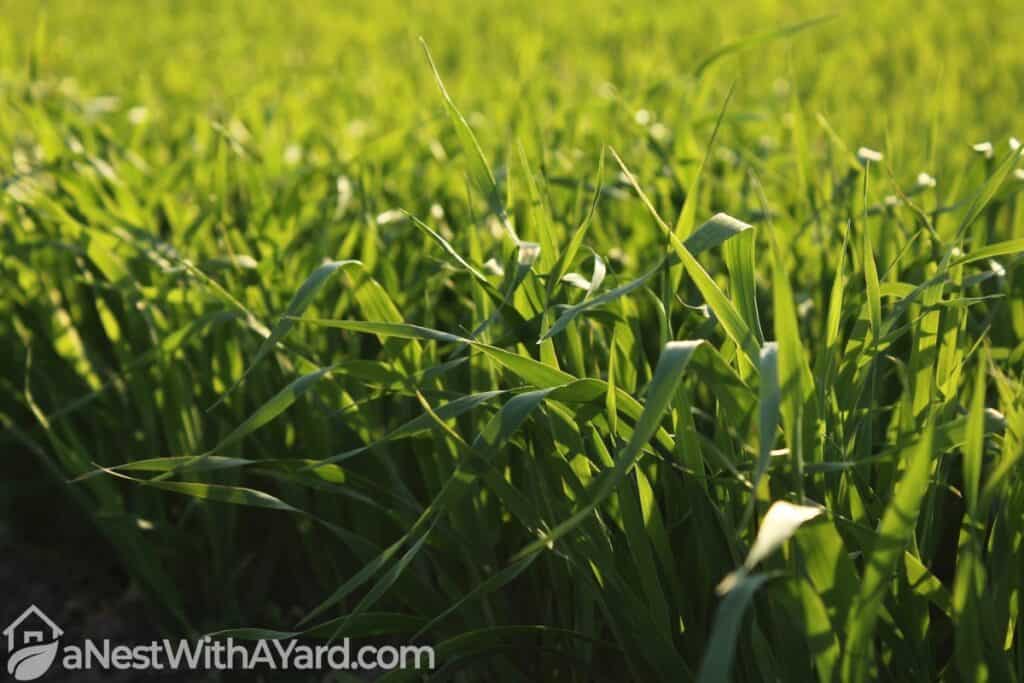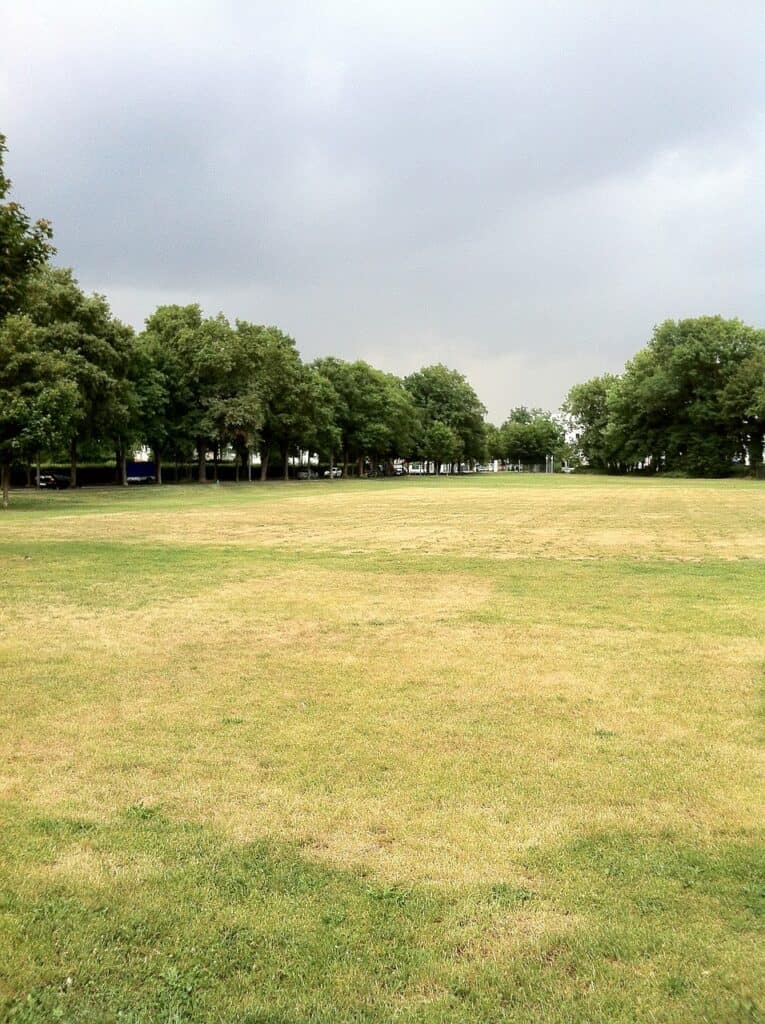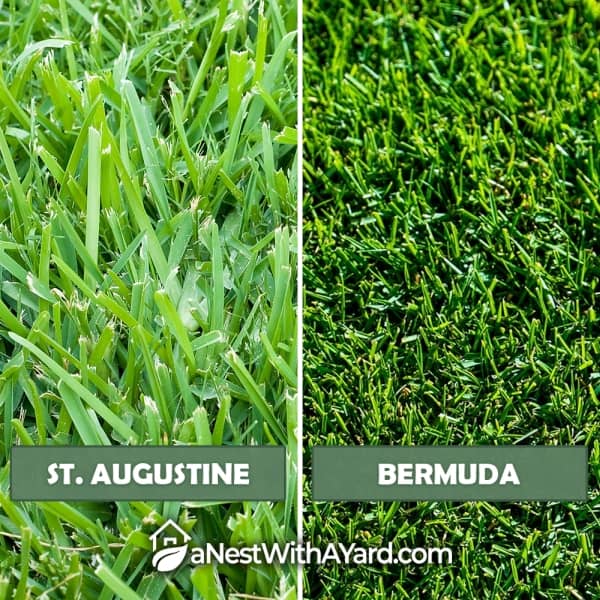There is a fine line between being able to revive dead St Augustine grass and needing to start again. You need to look over your lawn thoroughly to find all possible factors that could be or could in the future contribute to the death of your St Augustine grass. This way you can eliminate the exact cause instead of spending precious time and trying out different fixes.

Why Is St. Augustine Grass So Popular?
Over the years, there has been an increase in homeowners making use of St Augustine lawns. It has become a popular choice for landscaping professionals and homeowners who are looking for a low-maintenance and attractive solution. This is because it is generally considered to be drought-tolerant and thrives again after the winter months.
It is, however, not invincible and can be affected by a variety of different conditions, just like other grass types.
Why Your St. Augustine Grass Is Dying
There are a number of factors that could be complicit in the death of your St. Augustine grass. The biggest reasons that this grass type fails to grow or grow well are diseases, lack of water and unhealthy soil.

Lawn Diseases
St. Augustine grass is prone to diseases like root rot, brown patch disease and gray leaf spot. Warm and humid weather creates favorable conditions for the spread of brown patches of dead grass in St. Augustine grass. Hot summer weather can encourage the appearance of gray leaf spot.
Excess Fertilizer
When getting their grass to grow, homeowners often push their lawns to get the grass to grow faster and thicker through the use of fertilizers. However, excess fertilizer can lead to too much nitrogen and extra chemicals, which can cause you to actually burn your grass.
You need to make sure you are using just the right amount of fertilizer so that it helps your lawn without burning your grass or its roots.
Insect Damage
During the summertime and through to early fall, grub infestation can be common in lawns. Grubworms, cutworms and sod webworms can all cause damage to the grass roots, which affects the whole plant.
Your grass ends up dying because it is unable to draw nutrients and water from the soil as the grubworms eat the roots. Chinch bugs are another common insect problem with St Augustine grass.
Drought Stress
The summer heat often brings drier weather. You could end up with dead grass if you are quite dependent on rain to water your grass. This grass type will turn brown and look to be dormant if it goes without water for a number of weeks as it thrives well if it is watered a few times a week.
Under Or Overwatering
You need to make sure that you are giving your grass enough water but you also don’t want to drown it. If you give your grass too much water you could cause the roots to rot, but if you don’t water it enough, you could cause your grass to dry out.
Poor Soil Quality
Poor soil quality can have an impact on your St Augustine grass.
Having a thin topsoil layer with rocks, gravel or heavily compacted clay soil can cause issues for your Augustine lawn as the roots cannot extend deep enough to grow and develop in a healthy manner.
Keen to learn more about St Augustine grass? Check out this video by YouTube user The Lawn Care Nut for tips on caring for this beautiful grass type:
How To Revive Your St. Augustine Grass
Depending on what the underlying issue is that is contributing to dead St Augustine lawn, it can be revived if it has appeared dead for less than five weeks.
Let’s look at a few ways you can bring your St Augustine grass back:
Give Your Lawn The Water It Needs
Water your grass around three times a week during extended periods of hot and dry weather, as your St Augustine grass may start to die during this type of weather. Make sure that you are giving your lawn enough water to bring it back to life and ensure that the water is reaching the grass roots.
The recommended amount is around ¾ inches of water twice a week. However, you may need to give a total of 1 ½ inches of water every week. Unfortunately, it is possible that if the lawn is totally dead due to lack of water or drought, you may not be able to revive it. If it has worked, you should begin to see your grass growing back and going green again after three to four weeks.
Protect Your Lawn Against Drought
Drought stress is something that can kill your St Augustine grass, thus there are some precautions you can take to protect your lawn from this. This includes installing extra sprinklers around bare patches or areas that you think will get brown grass faster.
The key factor in keeping this grass type healthy and thriving is ensuring that you take care of the root system, particularly during dry and hot weather.
Improve Your Soil Quality

If you have figured out that the reason for your dead St Augustine grass is because the soil quality is poor, there are a number of things you can do to improve it and promote your grass to grow strong and healthy.
Improving the soil quality of your lawn is an important factor in maintaining a healthy lawn.
This includes the following:
- Aerate your soil. To help your grass to survive and thrive, aerate your soil, particularly if you have clay soil. Clay soil that’s heavily compacted can be a big culprit in St Augustine grass dying.
- Do soil tests. Doing soil tests will help you to find out what you need to give your lawn to help it thrive such as more or fewer nutrients and organic matter. To bring back dead St Augustine grass, you need to make sure that your lawn has approximately 5% organic matter.
- Ensure you have a good layer of quality soil to help your roots to grow deep thus helping to keep your St Augustine lawn healthy.
Fertilize Correctly
As mentioned earlier, using too much fertilizer on your lawn can burn it. It is recommended that you do it in the spring or fall, preferably before the summer heat, and only do it once a year.
Your choice of fertilizer will depend on what nutrients you need to add to your soil. Depending on what you prefer, you can usually choose between liquid or granular forms of fertilizer, however, it is recommended that you always read the label before using any type of fertilizer product.
Fertilizers such as 10-10-10 fertilizer have more nutrients for your grass such as phosphorus and nitrogen.
Make Use of Pesticides
If you spot an infestation of pests like grub worms, chinch bugs or cutworms, you should treat it as soon as possible. The faster you treat it, the more likely it is you will be able to prevent it from spreading elsewhere on your lawn. It is recommended that you try to treat the infestation with a combination of both nontoxic and organic pesticide treatments.

Replant Your Grass
If you don’t catch it fast enough, sometimes the easiest and most effective solution to extensive lawn damage is to start from scratch. For any bare spots on your lawn, the best thing to do is to rake over the dead grass to make it easier to remove it. After you’ve removed the dead grass, you can fill your bare spots with new grass.
Dethatch Your Lawn
In addition to aerating your lawn, it is a good idea to dethatch your lawn. This is because thick thatch creates a good environment for lawn diseases and insects. Too much thatch in this grass can suffocate and slowly kill your lawn.
Curious about how to cut St Augustine grass? Check out this YouTube video by eHowGarden for all you need to know:
Bermuda Grass Versus St Augustine Grass

As with everything, both grass types have their own advantages and disadvantages.
Bermuda grass tends to be able to withstand hot weather without water better as it requires little water when dormant. Bermuda grass requires a more nutrient-rich soil than St Augustine grass.
St Augustine tends to be more weed resistant, and as long as the soil is well-draining, it can thrive in most types of soil. It also does not require as much sunlight as Bermuda grass, but it does require twice as much water.
Both these grass types have been found to be good grass choices for homeowners living in Florida. However, generally, Bermuda grass comes more recommended when choosing what grass you want for your lawn when living in Florida.
FAQs
Can Dead St. Augustine Grass Come Back?
Dead St. Augustine grass can come back depending on the reason for its browning. You will not, however, be able to revive it if it stays dead for too long because the roots will die.
What Can I Put On My St. Augustine Grass To Make It Grow?
You can put a high phosphorus and high nitrogen fertilizer on your St. Augustine grass to make it grow. You can also water it more often and ensure you have the right components in your soil through soil tests.
Does St. Augustine Grass Reseed Itself?
St. Augustine grass does not normally reseed itself the way that other grass does as it does not generally produce viable seeds. The grass will grow seed heads however the seeds do not tend to grow.
Why Is My St. Augustine Grass Not Growing?
Your St. Augustine grass is not growing because of any of the following reasons. These include unhealthy soil, a lack of water, an overload of fertilizer and lawn diseases/insect infestations.
How Do You Fix St. Augustine Dead Patches?
You can fix St. Augustine dead patches by doing a number of things. This includes watering it more, aerating your soil and adding fertilizers.
Ready To Revive Your St Augustine Grass?
A number of different factors can result in St Augustine grass dying. However, in most cases, if you catch it early enough, you can revive your lawn. If you don’t catch it in time, you will unfortunately probably need to start from scratch. It is difficult to bring back St Augustine grass that has been dead for over five weeks.
We hope you found this article helpful. Please let us know in the comments below and share this with a friend!





More Stories
Green Housekeeping Tips for a Sustainable Lifestyle
How to Create the Perfect Housekeeping Schedule
Must-Have Housekeeping Supplies for Every Household